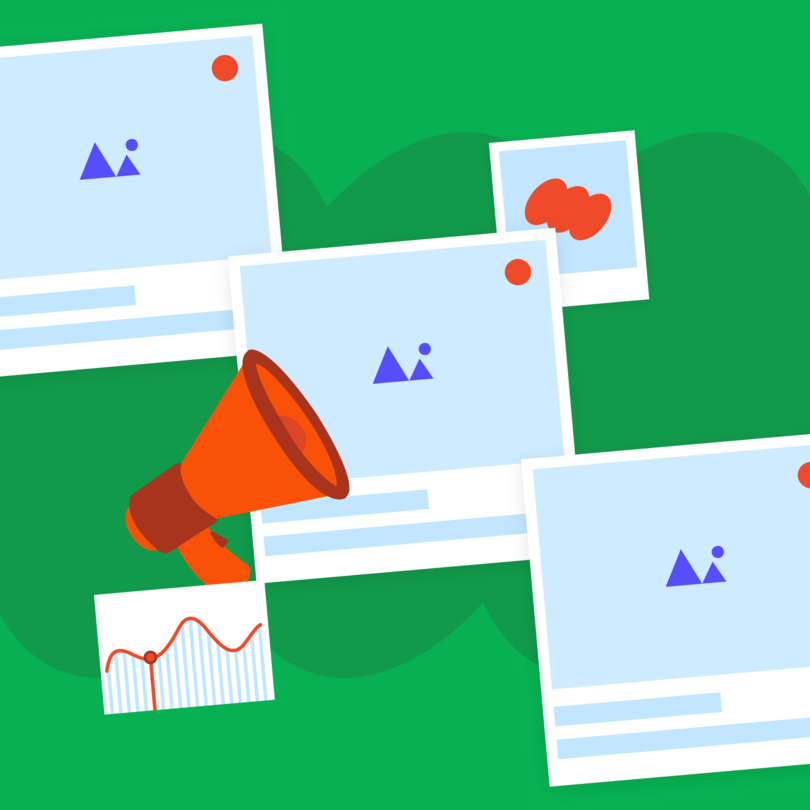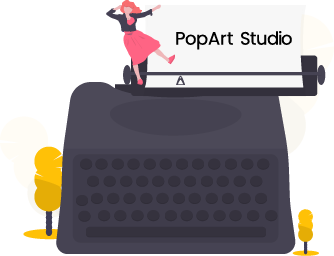Remember when AI gave you outdated info? Not anymore.When ChatGPT4 appeared in early 2023, it stirred up seismic reactions across industries (and the world itself). Some were relieved that, at least, it couldn't perform a real-time search. Others knew it was a matter of time before it would become possible.
That time is now. On October 31, 2024, OpenAI introduced the long-awaited search function. Albeit ChatGPT never really left the public conversation, this update took its potential and controversy to another level.
The big questions are: Is this the beginning of Google’s end? Will it change SEO forever?
OpenAI’s CEO, Sam Altman, already touted that he uses ChatGPT as his primary search engine while adding that Gen Z relies on it for major life decisions.
Curious how ChatGPT search works? This article breaks down the feature, how it compares to traditional search, who it’s for, and how you can make your content stand out in its results.
What is the ChatGPT Search Feature?
ChatGPT’s new search function allows the model to access real-time information from the internet and is available to all users, including those on the free tier. It’s a major leap from its legacy form, which relied solely on pre-trained data with a cutoff in 2023.
Now, when you select “Search the web” or explicitly prompt it to find up-to-date data, ChatGPT can pull information on current events, news, trends, or recent research.
Free-tier users can access GPT-4 with web browsing a limited number of times every five hours, while paid users enjoy more frequent access. But unlike Google, ChatGPT doesn’t search automatically, so you have to initiate it.
How the ChatGPT Search Function Actually Works
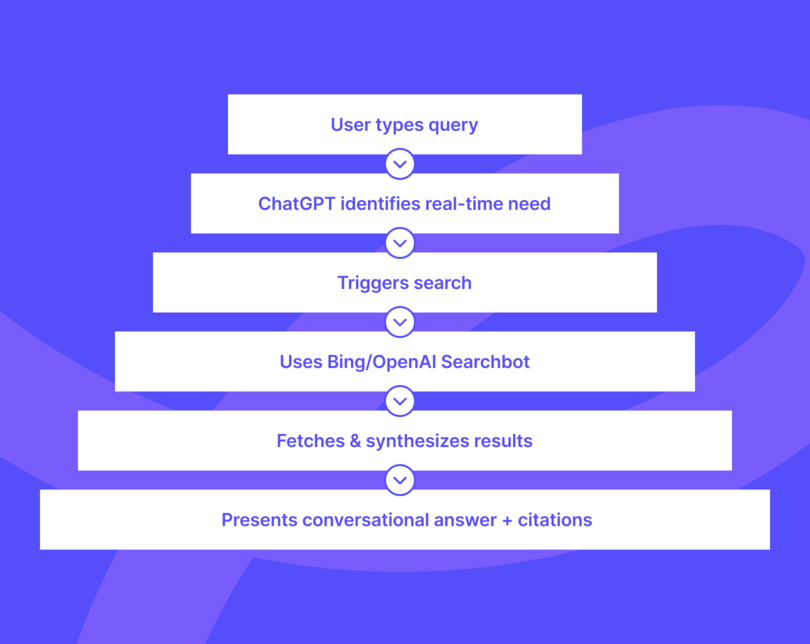
When you prompt ChatGPT’s search feature, it sends a query through Bing, skims the top results, and pulls key details from the pages it finds relevant. You don’t just get a list of links but a distilled summary.
A small 🌐 icon marks live search responses, and numbered or bracketed links point to the sources it used, and you can click through to verify. ChatGPT search favors high-authority sources like major news outlets, official organizations, and trusted blogs. However, it can’t bypass paywalls, access private databases, or pull from platforms like Instagram or TikTok.
Unlike static ChatGPT replies, which are based on old data, the new search feature offers live snapshots of what’s online now. But think of it less as a search engine and more like a very quick (but still fallible) researcher. The point is, always click through and think for yourself.
ChatGPT Search vs Traditional Search Engines
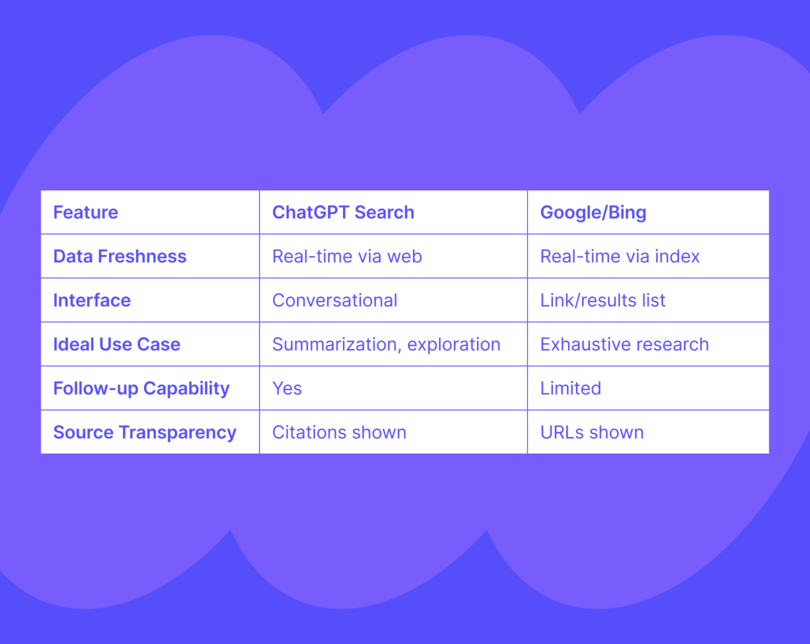
Despite the hype and hand-wringing, ChatGPT Search isn’t necessarily here to dethrone Google because it works differently. Google gives you a ranked list of links, and now, with AI Overviews, it also includes a generated summary at the top. However, those summaries often pull from multiple sites without clear attribution, and clicking through can feel like guesswork.
ChatGPT, on the other hand, is more of a researcher than a search engine. OpenAI’s app reads top-ranking pages in full, extracts what matters, and gives you a direct, sourced answer. You’ll see clickable citations, not vague references or SEO-optimized blurbs.
Another key difference is that Google assumes you want to browse. ChatGPT assumes you want an answer. That means no ads, no sponsored results, and no algorithmic clutter.
Instead of flooding you with ten tabs, ChatGPT condenses what it finds into a focused reply. You’re not just searching but delegating the reading. The experience is conversational, follow-up-friendly, and built for summarization. You can clarify, go deeper, or pivot without starting over.
That said, ChatGPT can’t index the entire web in real time the way Google can. It works within a narrower, curated slice of the internet. For open-ended research, breaking trends, or obscure forums, Google still offers broader ground.
And where does Bing fit into all this? Bing Search also leans on AI, as its Copilot side panel can summarize content and assist with queries, but it stays rooted in a traditional search engine layout.
You’ll still get the link list, ads, and product carousels alongside the AI help. It’s a hybrid and offers summaries without ditching the old structure.
So, who should use what?
- Use ChatGPT when you want clear, direct answers, quick summaries, and a natural conversation.
- Use Google when you need to cast a wide net, verify sources independently, or dig through niche corners of the web.
- Use Bing if you want AI assistance but still prefer a classic search layout.
In a nutshell:
ChatGPT’s strength is clarity and flow.
Its weakness is limited scope.
When and Why You Should Use ChatGPT Search
ChatGPT search is your best bet in cases like:
- Planning a trip and comparing itineraries
- Researching products based on aggregated reviews
- Asking broad questions like “How do I set up a newsletter?”
It’s more helpful for students, marketers, and journalists who need quick summaries or fast orientation on a topic, including those exploring how to use AI in digital marketing.
If you want to trigger it manually, either choose the globe icon in the tools menu or write a prompt like:
“Search the web for the latest on EV battery breakthroughs.”
Common Misconceptions About the ChatGPT Search Feature
Whenever a feature is new, users have questions and doubts about it. Here are the main ones surrounding the ChatGPT search.
“Is it the same as Google?”
No. ChatGPT search doesn’t index the entire web or deliver long lists of links. Instead, it curates information and gives you an answer, often skipping over the clutter.
“Does it give you everything on the web?”
No, again. The ChatGPT search feature pulls from what’s publicly accessible and available via Bing, so what you get is filtered and summarized, not dumped.
“Can you trust it blindly?”
Absolutely not. While it’s fast and often accurate, the ChatGPT search function depends on what’s available and how recent or well-sourced the content is. Think of it as a helpful assistant, not a flawless oracle. Always double-check the sources.
How ChatGPT Is Changing the Way People Search
More than anything, ChatGPT is changing how people search. Traditional search is keyword-driven. ChatGPT encourages a conversational flow, so something closer to thinking out loud.
Semrush found that just 30% of prompts to ChatGPT fit into traditional “search intent” buckets like informational or transactional. The rest fall into planning, brainstorming, and ideation, which are things that don’t even show up in Google’s logs.
Prompt length reflects this shift. Without the search feature, ChatGPT users write queries averaging 23 words. With search turned on, that shrinks to 4.2, which is short and Google-style phrasing.
Search Engine Land noted a similar trend. Most queries now begin in the discovery phase. Instead of typing “ConvertKit pricing,” users ask, “What’s a good platform to send newsletters?” or “How do I follow up automatically?”
Referral traffic from ChatGPT also skyrocketed, from fewer than 10,000 unique domains a day in July 2024 to over 30,000 by November. It’s not just about traffic but a new habit.
People now treat ChatGPT as a decision-making co-pilot. And marketers need to shift with that and optimize not just for visibility but for the flow of how people think, ask, and decide.
ChatGPT Search May Become a Super Assistant in the Future
It’s easy to assume that OpenAI is chasing Google’s search dominance, but they’re laying the groundwork for something bigger, which is turning ChatGPT into a full-blown personal assistant. In 2025, it added native shopping features to ChatGPT and allowed users to browse product recommendations with buy buttons embedded directly in the interface.
According to Wired, the results rely on aggregated web reviews and user preferences, not ads, offering a more organic alternative to Google Shopping. While checkout still happens on external sites, the intention is clear. ChatGPT aims to stay central in the consumer journey, from curiosity to conversion.
But that’s just the surface. Leaked documents cited in BGR show OpenAI’s plan to evolve ChatGPT into a “super-assistant,” a persistent, personalized AI that can manage tasks across devices, remember your preferences, and interact socially. It won’t just suggest office chairs but also plan vacations, draft emails, and track your calendar.
Hardware is in the works too, reportedly through a wearable developed with Jony Ive’s company, hinting at an always-on, voice-aware AI layer.
This trajectory isn’t about smarter search as much as it’s about presence. ChatGPT is becoming more involved in product discovery and everyday decision-making, so SEO trends are starting to move toward creating content that feels genuinely useful and trustworthy, making you the most helpful voice in the room.
How Can Marketers Use ChatGPT Search to Their Advantage?
Changes keep coming, and the only choice marketers have, if they want to maintain their visibility, is to adapt and find ways to thrive. Since ChatGPT search is bound to affect how people find and process information, your strategy should go beyond traditional SEO tactics.
This isn’t about climbing ten blue links anymore. The trick is in training your content to be conversation-ready.
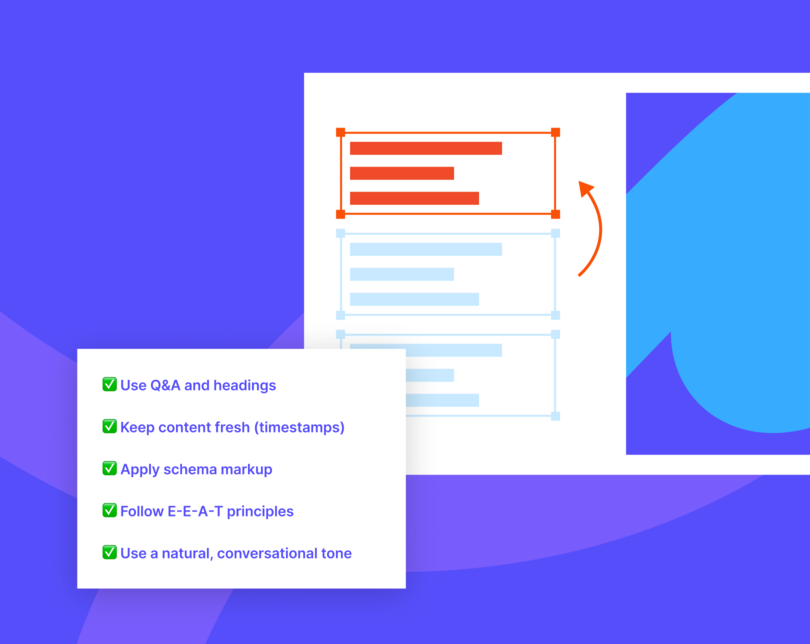
1. Structure for Summarization
The ChatGPT search feature favors well-structured and skimmable content. Think of it as formatting for AI digestion.
This means using short paragraphs, subheadings, bulleted takeaways, and clear answers to common queries should be your go-to approach. If your post reads like a helpful conversation, it’s already ahead of the pack.
2. Focus on Substance Over Metadata
Over-the-top headlines and meta tricks matter much less than the content in the new search generative experience. Generative models often pull text directly from body copy, so your content should be valuable even when taken out of context.
3. Feed the Model with the Right Signals
Publish original insights, answer niche questions, update regularly, and create expert content instead of surface-level summaries. Don’t chase generic keywords and focus on what only you can say, whether that’s, for example, case studies or proprietary data.
ChatGPT search tends to surface content that it has “seen” in high-trust sources or across multiple contexts. That means your best move is to seed your content across reputable platforms, so think guest posts, citations, and even LinkedIn articles. Repurpose smartly and cross-pollinate.
Also, make sure your content is AI-readable:
- Use clean, descriptive headings
- Include definitions or explanations in natural language
- Prioritize clarity over cleverness
4. Adapt to New SEO Expectations
You can’t rely on old playbooks. Instead, start tracking how AI reshapes discoverability:
- Prompt-based formatting
- Clean semantic structure
- AI-aware schema
5. Audit Your Brand’s Search Presence
Ask ChatGPT what it knows about your product or niche. If your name doesn’t show up, you’re not part of the conversation yet.
Final Thoughts
ChatGPT Search isn’t quite ready to replace Google just yet, but it’s undoubtedly slowly redefining what people expect from information tools.
For anyone whose goal is clarity, not clutter, and an answer instead of ten tabs, ChatGPT delivers. It’s even more valuable for anyone who wants to shortcut research, synthesize updates, get fast context without falling down the search rabbit hole, or explore an idea from multiple angles.
Search behavior will imminently keep shifting, which also changes how brands need to show up online. Businesses that want to stay visible, especially in an AI-first world, will increasingly need smart and adaptive digital marketing services to keep up.
Right now, ChatGPT is still a tool, but a future where it becomes the primary way we interact with the web isn’t so far-fetched. So, whether you’re a student, a brand, or just someone curious about the world, it’s worth giving this new way of searching a try.

